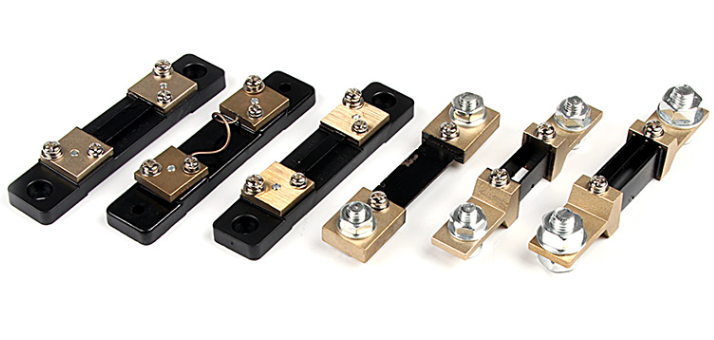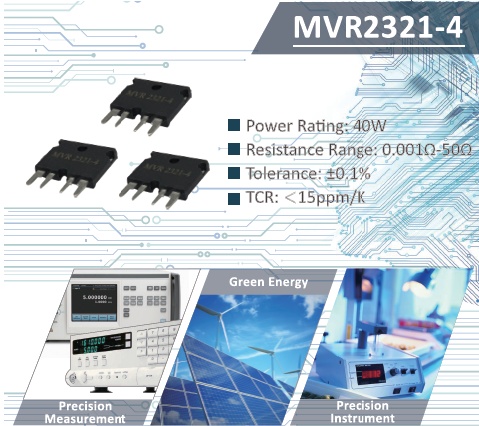Position:Home » Technical Articles
Ammeter Shunt Resistors' Features
Writer:Microhm Page View:Date:2019-10-12
Ammeter shunt resistor operation is well-understood. Used extensively for current measurement in the past, the resistors are used to “shunt” most of the current around the measurement instrument. This technique allows measurement of greater currents than is possible using normal ammeters. The low-value resistor is situated in series with the load, creating a small voltage drop across the resistor, which can be measured using a voltmeter. The current is then calculated using Ohm’s law.

Modern ammeter shunts are a bit more complex. The value of the shunt resistor works with the voltmeter to provide the maximum deflection at the maximum-rated current of the shunt. At that current, the design normally has a voltage drop of 50, 75 or 100 mV. In a typical example, a resistor that would measure a current of up to 100 A, with a 100-mV voltage drop, would have a value of 1 mΩ. For higher currents, a lower value of resistor would be required, with lower voltage drops.Microhm Electronics' ammeter shunt resistor FL-2 type are widely used in meters.
With such a low resistance, it has to be defined precisely in advance, and any other elements in the systems that could cause errors must be eliminated. One way to reduce potential erroneous measurements is to use a four-terminal resistor to keep the load connections separate from the measurement terminals. MVR2321-4 is a 4-terminal precison resistors used for current measurement for meters as well.

Many materials used to manufacture resistors are susceptible to temperature variation. When trying to measure with an accuracy of 0.1%, the resistor material must have a low temperature coefficient of resistance (TCR). For example, Manganin alloy can be used for shunt ammeter resistors because its TCR is stable over a temperature range of −40 to +60ºC.

Modern ammeter shunts are a bit more complex. The value of the shunt resistor works with the voltmeter to provide the maximum deflection at the maximum-rated current of the shunt. At that current, the design normally has a voltage drop of 50, 75 or 100 mV. In a typical example, a resistor that would measure a current of up to 100 A, with a 100-mV voltage drop, would have a value of 1 mΩ. For higher currents, a lower value of resistor would be required, with lower voltage drops.Microhm Electronics' ammeter shunt resistor FL-2 type are widely used in meters.
With such a low resistance, it has to be defined precisely in advance, and any other elements in the systems that could cause errors must be eliminated. One way to reduce potential erroneous measurements is to use a four-terminal resistor to keep the load connections separate from the measurement terminals. MVR2321-4 is a 4-terminal precison resistors used for current measurement for meters as well.

Many materials used to manufacture resistors are susceptible to temperature variation. When trying to measure with an accuracy of 0.1%, the resistor material must have a low temperature coefficient of resistance (TCR). For example, Manganin alloy can be used for shunt ammeter resistors because its TCR is stable over a temperature range of −40 to +60ºC.
Keywords:
Latest News
- Resistor's role in measuring and correcting LED,,,
- Single through-hole resistors' characteristics ,,,
- Why shunt resistors for current sense applicati,,,
- Metal-film resistors with small size, high resi,,,
- 36W High-Current Shunt Resistors MMS8420,,,
- 1W Surface Mount Resistor MPR1206,,,
- An Overview of Microhm Electronics' Resistor Pr,,,
- More anti-sulfur resistors used in harsh envir,,,
- Resistance changes with temperature,,,
- 140W TO247 High Power Heatsinkable Resistor,,,
- MMS5930 is ideal for current sensing in industr,,,
- Shunt resistors selection for engineers' design,,,
- Considerations for choosing precision resistors,,,
- Ceramic Encased Cement Resistors NWH Series for,,,
- Resistors for Passive Balancing in Battery-Pow,,,
Hot Articles
- Microhm will take part in 10th Automotive World,,,
- Thanks for Visiting Microhm's Booth E5-5706 in ,,,
- Resistors in Short Supply: Blame Cars,,,
- New lunch: High Power Precision Shunt Resistor,,,,
- How to Test a Resistor,,,
- Innovative Technology, Future Electric: Electri,,,
- What is Precision Resistors?,,,
- SMD Resistors Sizes and Packages,,,
- The Construction and Features of Metal Film Res,,,
- What is a TO-220 Resisor?,,,
- Hot Selling Products: Precision Shunt Resistors,,,
- How to Calculate the Equivalent Resistance Valu,,,
- What is a Fixed Resistor?,,,
- Resistors in LED Circuits,,,
- Resistors Types and Materials Overview,,,
Resistance applications
- Heater Blower Motor Resistor in Air Conditioner,,,
- Surface Mount Resistor's Size and Package ,,,
- Why Zero-Ohm Resistors?,,,
- The Four Important Functions of Alloy Resistors,,,
- Shunt Resistor MMS8420 for High Current Stable ,,,
- Miniature future for passive electronic compone,,,
- Carbon Film Resistors' Features and Application,,,
- The Main Application for High Precision and Low,,,
- Urbanization Development Bringing the Transform,,,
- Precision Resistors' Construction and TCR,,,
- The Measurement Accuracy of Automotive Shunt is,,,
- BMS for New Energy Vehicle,,,
- Industrial Roberts Applied to Solar Photovoltai,,,
- Difference Between High Precision Resistors and,,,
- Select the Right Resistor for Harmonic Filterin,,,
